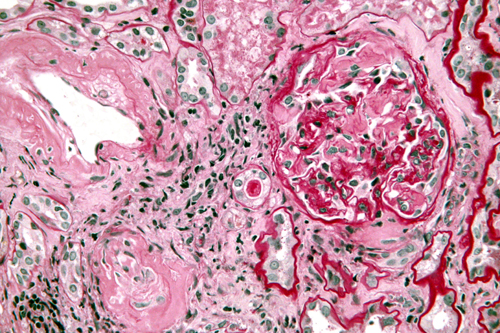Dr. Surinder Sodhi
Amyloidosis is a rare disease that occurs when amyloid proteins are deposited in tissues and organs. Amyloid proteins are abnormal proteins that the body cannot break down and recycle, as it does with normal proteins. When amyloid proteins clump together, they form amyloid deposits. The buildup of these deposits damages a person’s organs and tissues. Amyloidosis can affect different organs and tissues in different people and can affect more than one organ at the same time. Amyloidosis most frequently affects the kidneys, heart, nervous system, liver, and digestive tract. The symptoms and severity of amyloidosis depend on the organs and tissues affected.
What types of amyloidosis affect the kidneys?
Primary amyloidosis and dialysis-related amyloidosis are the types of amyloidosis that can affect the kidneys.
Primary Amyloidosis of the Kidneys
The kidneys are the organs most commonly affected by primary amyloidosis. Amyloid deposits damage the kidneys and make it harder for them to filter wastes and break down proteins. When the kidneys become too damaged, they may no longer be able to function well enough to maintain health, resulting in kidney failure. Kidney failure can lead to problems such as high blood pressure, bone disease, and anemia—a condition in which the body has fewer red blood cells than normal.
Dialysis-related Amyloidosis
People who suffer from kidney failure and have been on long-term dialysis may develop dialysis-related amyloidosis. This type of amyloidosis occurs when a certain protein, called beta-2 microglobulin, builds up in the blood because dialysis does not remove it completely. The two types of dialysis are hemodialysis and peritoneal.
Hemodialysis uses a special filter called a dialyzer to remove wastes and extra fluid from the blood. Peritoneal dialysis. Peritoneal dialysis uses the lining of the abdominal cavity—the space in the body that holds organs such as the stomach, intestines, and liver—to filter the blood.
Dialysis-related amyloidosis is a complication of kidney failure because neither hemodialysis nor peritoneal dialysis effectively filters beta-2 microglobulin from the blood. As a result, elevated amounts of beta-2 microglobulin remain in the blood. Dialysis-related amyloidosis is relatively common in people with kidney failure, especially adults older than 60 years of age, who have been on dialysis for more than 5 years.
What are the signs and symptoms of primary amyloidosis of the kidneys?
The most common sign of primary amyloidosis of the kidneys is nephrotic syndrome––a collection of signs that indicate kidney damage. The signs of nephrotic syndrome include albuminuria—an increased amount of albumin, a protein, in the urine. A person with nephrotic syndrome excretes more than half a teaspoon of albumin per day.
Hyperlipidemia—a condition in which a person’s blood has more-than-normal amounts of fats and cholesterol. edema—swelling, typically in a person’s legs, feet, or ankles and less often in the hands or face.
Hypoalbuminemia—a condition in which a person’s blood has less-than-normal amounts of albumin.
Other signs and symptoms of primary amyloidosis may include fatigue, or feeling tired shortness of breath low blood pressure numbness, tingling, or a burning sensation in the hands or feet weight loss.
What are the symptoms of dialysis-related amyloidosis?
The symptoms of dialysis-related amyloidosis may include pain, stiffness, and fluid in the joints abnormal, fluid-containing sacs, called cysts, in some bones. Carpal tunnel syndrome, caused by unusual buildup of amyloid proteins in the wrists. The symptoms of carpal tunnel syndrome include numbness or tingling, sometimes associated with muscle weakness, in the fingers and hands.
Dialysis-related amyloidosis most often affects bones, joints, and the tissues that connect muscle to bone, called tendons. The disease may also affect the digestive tract and organs such as the heart and lungs. Bone cysts caused by dialysis-related amyloidosis can lead to bone fractures. Dialysis-related amyloidosis can also cause tears in tendons and ligaments. Ligaments are tissues that connect bones to other bones.
How is primary amyloidosis of the kidneys treated?
A health care provider treats primary amyloidosis of the kidneys with the following:
medication therapy, including chemotherapy a stem cell transplant treating other conditions
Medication therapy. The goal of medication therapy, including chemotherapy, is to reduce amyloid protein levels in the blood. Many health care providers recommend combination medication therapy such as melphalan , a type of chemotherapy dexamethasone an anti-inflammatory steroid medication
These medications can stop the growth of the cells that make amyloid proteins. These medications may cause hair loss and serious side effects, such as nausea, vomiting, and fatigue.
Stem cell transplant. A stem cell transplant is a procedure that replaces a patient’s damaged stem cells with healthy ones. Stem cells are found in the bone marrow and develop into three types of blood cells the body needs. To prepare for a stem cell transplant, the patient receives high doses of chemotherapy. The actual transplant is like a blood transfusion. The transplanted stem cells travel to the bone marrow to make healthy new blood cells. The chemotherapy a patient receives to prepare for the transplant can have serious side effects, so it is important to talk with the health care provider about the risks of this procedure.
Treating other conditions. Primary amyloidosis has no cure, so treating some of the side effects and other conditions seen with the disease is essential.
(The author is a faculty in Nephrology, GMC)


